Site founded September 1, 2000, passing 375,000 page views in April 2005
These home pages remain free of any charge. We need donations or subscriptions/gifts for students, military and family. Please pass on this website link to your family, relatives, friends and clients.
|

|
of History & Folklore
Subscribers Edition Stories & Photos
The most in-depth, comprehensive site about the Skagit.
Covers from British Columbia to Puget sound. Counties covered: Skagit, Whatcom, Island, San Juan. An evolving history dedicated to the principle of committing random acts of historical kindness
|
Noel V. Bourasaw, editor  810 Central Ave., Sedro-Woolley, Washington, 98284 810 Central Ave., Sedro-Woolley, Washington, 98284
Home of the Tarheel Stomp  Mortimer Cook slept here & named the town Bug Mortimer Cook slept here & named the town Bug
|

|
Andrew and Mary Ann Jackman, their extended
family and the Log Cabin Inn of Marblemount
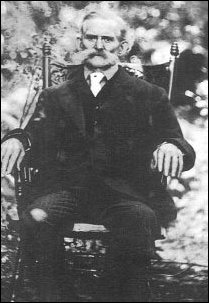 |
Andrew Jackson Jackman
|
By Noel V. Bourasaw, Skagit River Journal, ??2005
Andrew Jackson Jackman was one of those bachelor miners who braved the upper-Skagit wilderness alone, miles from any civilization, much less the fairer sex. Anyone who has lived alone during the incessant November rains can multiply his experience by about a hundred to imagine what Jackman's life must have been like. From family records, we have deduced that he moved to upper-Skagit area sometime between 1882 and 1884. From various bits and pieces of records, we think he came here to join his fellow Maine native, F. Albert Bacon, who opened the profitable Nip and Tuck mine near Ruby creek during the gold rush of 1879-80. Like many miners and outdoorsmen, his social life centered on a saloon that he owned. And like many of his fellow pioneers of those early years, he soon found a young Indian girl as a companion and wife.
Jackman's parents were obviously fond of the seventh president. Andrew was born on Oct. 3, 1836, at the end of Andrew Jackson's term, in the far-east corner of Maine near Passamaquoddy Bay and Grand Manan Channel, ten miles from border of New Brunswick. That is the only definite information we have about him and his family in Maine. While researching, we discovered that there is a small village of Jackman on the Moose river, west of Moose Lake and the Longfellow mountains. The village is clear across the state, on the Old Canada road, 15 miles east of the Quebec border and 50 miles northeast of the New Hampshire border. The town became a stop on the Canadian Pacific Railroad, which looped through northwest Maine in the early 1880s.
We inquired of local historical societies and Marilyn Sterling-Gondek of the Old Canada Road Historical Society provided information about the formation of the village. A Holden family settled the Jackman, Maine, area near the turn of the 19th century. A Revolutionary War soldier named Enoch Jackman had a son named James Jackman and they lived in Solon, Maine, southeast of Moosehead Lake. James, usually called Captain Jackman, was hired by the state to construct what became known as the Old Canada Road and the state granted him a quarter section of land. He and his wife, Betsy Whipple, moved there and had eight children. None of them were the Jackmans of our story. James went to California for two or three years in 1864 and then moved to Kansas, where he died in 1872. So far, we have not found any connection between Andrew's family and the family that settled the village of Jackman.
Jackman family members and research
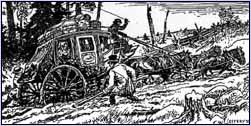 |
Old Canada Road
|
We have no record of Andrew Jackson Jackman's childhood other than one federal census in Charlotte in 1850. The father of the Jackman family was Joseph Sr., then 57, and the three eldest children were a 19-year-old girl named Parmelia — the oldest; Joseph Jr., 17; and Andrew, 14. The first we know of Andrew as an adult was when he was recorded in the 1860 federal census while living on the Sacramento river delta. He and his older brother Joseph probably went West via the Isthmus of Panama, along with other Maine friends, seeking gold at the tail end of the rush in California. Family tradition has always cited their trip West around Cape Horn, but few passengers took that route after 1855 when a railroad opened across the Isthmus and ships took passengers to the eastern shore and other ships took them from the western shore to San Francisco. From that time until the transcontinental railroad opened 14 years later, only heavy freight was carted "round the horn." Since Andrew's name is in Seattle court records of 1883, we assume that the brothers apparently moved to Washington territory sometime in the early 1880s. His family also found a record that Andrew briefly lived in the territory two decades earlier, in 1864, but he and Joseph both soon returned to California.
Sometime in 1882-83, Andrew moved to the upper Skagit river and apparently first made his living there as a prospector or miner. We know these details because of Shirley and Hal Williams, who both graduated from Concrete High School in 1955. Shirley has retained very old family records and documents and then visited the northwest Washington state regional archives, where she found many more public records from a century ago. Andrew was Shirley's great-grandfather. Shirley's mother, Marjorie "Marge" (Thompson) Voth, grew up in Everett but visited her grandmother often. Marge was interviewed years ago by Wanda Adams of the Everett Herald and recalled how Andrew met his future bride soon after moving to the river:
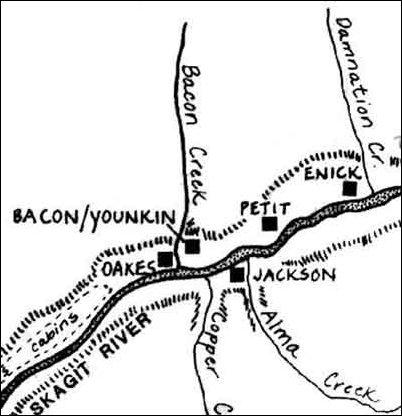 |
National Park Service map of the area around Bacon creek and the pioneers who lived there in the 19th century
|
Marge Voth's memories of her grandmother are [hazy because] she did not see her as often [as the other women interviewed]. But she remembers the story of her grandmother's life. Mary Ann Harry was of the group now known as the Upper Skagit tribe. She was born at the mouth of the Baker river (east side in 1868) and, until she was 14, she lived the seasonal, village-centered life of the Coast Salish.
She wore her hair naturally long; her clothes were buckskin; and she was tattooed to show who her father was. Her only connection with the white man was the Christian surname they had given her father.
And then Andrew Jackman came into her life. He owned the trading post at what is now Marblemount and he came from the state of Maine to the Skagit valley. Though he was not a young man [age 48], Jackman decided he wanted to marry, and his eyes fell on the daughter of his washerwoman, Mary's mother. As was the custom, he paid Mary Ann's father for her and prepared to become a married man.
But Mary Ann [age 16] wanted none of it. She ran into the woods and lived for weeks on berries and roots until her brother trailed her to her place of hiding and brought her back. It must have been hard for her those first years. her one comfort was the visits of her mother. Jackman tolerated those visits, but was very strict with his young wife, whom he had married in a Christian ceremony to please his white associates.
But her marriage was not a long one. Jackman died in 1909 and Mary Ann married again, an Indian this time. she mixed her Indian religious beliefs with the Shaker religion, moved back to the area of her childhood. And Marge says she was "much happier." Marge's grandmother was free to be an Indian once more.
We know from records compiled right after Skagit county was formed that Jackman applied for a marriage license on June 10, 1884; Mary Ann's surname was mistakenly recorded as Mary Anna Henry instead of Harry. Harrison Clothier, the co-founder of Mount Vernon and a merchant there, was the "affiant" on the record. Clothier, a Democrat, had just been elected that winter as a member of the first board of commissioners for the new Skagit county, which was formed in November 1883. Shirley found the actual record of the wedding at the archives. A handwritten record in an old ledger book by Justice of the Peace Robert E. Cockreham notes that the couple married on June 18 at his home "near Birdsview." The witnesses were other settlers, William McCloud [hard to read] and William Gholson.
When Marge was interviewed by Peter Heffelfinger and Pearl White, in a 1977 Skagit county oral history project, she explained that it was often the tradition in the old Upper Skagit tribe that a young daughter was given to a husband, with or without her choice. While living in the area of future Marblemount in the early 1880s, Andrew hired Mary Ann's mother as a washerwoman. Marge recalls her grandmother telling her that Mrs. Harry rode to camps on horseback and picked up wash bundles. Andrew first saw Mary Ann when she was 14.
"She knew what he was talking [to her mother] about," Marge recalls, "because he had been making eyes at her and patting her. Then her mother told that she is to go with Andrew." As Marge noted above, Mary Ann fought the arrangement and ran away. She told Mary Ann that her brother found her by tracking where she picked berries and dug roots to eat, and where she broke branches while running through the woods. "Grandpa gave gold pieces [afterwards to her mother]."
Mary Ann's father had been killed sometime before that. "At first she was [unhappy]," Marge noted in the interview. "She was just a child but then she said he [Andrew] made a good living; he had food and things she didn't have in the camp." The marriage seems to have been a rocky roller coaster. Mary Ann told her granddaughter that Andrew would not allow his young wife to associate with her Indian friends. Her only access to the old ways was through visits from her mother, whom Andrew admired. Mary Ann told Marge that her grandmother also stayed with the couple at the trading post, smoking a clay pipe in front of a huge fireplace, and chatting with her daughter and granddaughter in the native Lushootseed language. Marge recalled that Mary Ann's greatest joy came from her four children.
The next challenge was to find where Jackman's home actually was when they were married. Birdsview was then the only upriver village of any size, clustered on both sides of the Skagit where Birdsey D. Minkler built his water-powered sawmill in 1878. The nearest town downriver was Sterling. Sedro was still a year away; Mortimer Cook arrived at that site in June 1884. So, the reference to Jackman's home being near Birdsview could have literally meant anywhere on the upper Skagit river, with his steamboat mail drop being at Birdsey Minkler's mill. The first reference we have found to Jackman in old newspapers is the first issue of the Skagit News of Mount Vernon on April 1, 1884, when their roving reporter quoted a "young Mr. Jackman," who said that there were a dozen men working in a logging camp where he worked someplace upriver.
First known Marblemount/Cascade river business
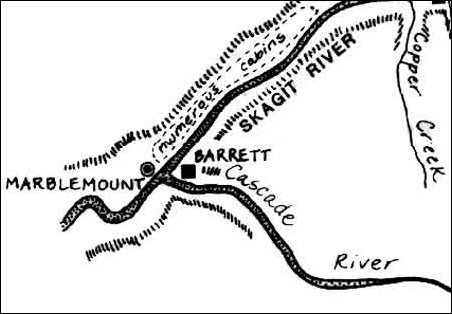 |
National Park Service map of the area around the junction of the Cascade and Skagit rivers and the site of early Marblemount.
|
The land records that Shirley Williams found are only partially helpful because we know that Andrew invested in land all over the upper Skagit river and the North Cascades, and we had to sort out which pieces were mining and timber land and which might have been for their home. The next record is a bill of sale for 160 acres, bought by Jackman from Peter S. Ferbrache on May 5, 1884, in section six, Township 35 North, Range 8 East. That lies just northwest of the future townsite of Grasmere, west of the Baker river and north of the Skagit. Is that where Andrew wed his reluctant bride? Mary Ann's parents were certainly members of an Upper Skagit Indian band that wintered at the mouth of the Baker, where it spills into the Skagit.
But Shirley Williams also has another more likely bill of sale in her family records, one dated April 21, 1884, where an Alexander Conrad sells to Andrew J. Jackman, for $50, his interest in their saloon and a raft of logs. To complicate matters, the record's location of that saloon is also "near Birdsview." But we do have one hint. When we researched records at the same archives noted above, we found this record: on March 7, 1891, partners Jackman and Joe Cozier, paid for the first "official" saloon license in the Rockport-Marblemount area, what was then officially called the Cascade precinct, in section 13, T35N, R10E. There was no village of Rockport yet back in 1884; that would come when the railroad arrived in 1901. There was not even a Marblemount yet; the was formed and named by Matilda Buller after she arrived with her sons in 1889. The Cascade district then encompassed the area around where the Cascade river emptied into the Skagit, east across the Skagit from the present Marblemount site. As you will see from another record below, this is the likely honeymoon site for the couple and the Jackman/Conrad saloon may have been the first business at future Marblemount. That legal location is centered almost exactly on the site of future Marblemount. Up until now, we have never found such a business recorded in that area before 1890. Conrad disappears after that from the public record.
The 160-acre site near future Grasmere may have just been another timber or mining investment. Shirley Williams found another deed at the regional archives, also dated April 21, 1884, which was also between Conrad and Jackman. For $300, Jackman bought 14 acres in section 14, T35N, R7E, which is smack dab in the middle of the old town of Birdsview. That may also have been an investment.
The Jackman couple's first child of four they had together was named Joseph, born in about November 1884, according to the May 1885 federal census. Soon thereafter a daughter named Mary Ellen was born. Their next child, Alice May — Shirley's grandmother, was born on Sept. 12, 1887. Although Shirley has assumed that these children were born at future Van Horn, we think they were born either at the Cascade river location or slightly west towards present-day Rockport, which was founded as the terminus of the Seattle & Northern railroad in 1900. Marge recalled in the 1977 interview that the two eldest children both died at the Cushman Indian hospital north of Tacoma, both dying of either small pox or measles in the epidemic of the 1890 period when hundreds of upriver Indians died. Some entire villages were nearly wiped out.
Andrew J. Jackman continued his investment in the far-upriver area. On April 21, 1890, logger-pioneer William Murdock sold about fifty acres of land in sections 28 and 29 of T35N, R10E. That is about two miles southwest of Tootsie Clark's Skagit River Resort, or roughly halfway between present Rockport and Marblemount. Jackman's location is further cemented in the results of the research that Gretchen A. Luxenberg conducted in the 1980s for her comprehensive National Park Service history website:
There were other individuals in the vicinity of Marblemount attracted more to the mining opportunities than to homesteading possibilities. Renny Durand (also known as Remi and Jack), Jack Jackman, and Joe Cozier were all associated with mining developments in the North Cascades. In 1891, Jackman and Cozier built a large hotel on ground they purchased from Renny Durand, ". . . in anticipation of the lively times expected in the Cascade mining district the coming prospecting season." Its location is not known. Durand also planned a townsite in 1891 but this site and whether it was ever platted remains unknown. He did file a homestead entry on land just west of Marblemount (T35N R10E, Section 12) which was patented in 1891. Durand was a well-known and well-liked miner, trapper, and hunter who worked the Colonial Mine on Colonial Creek, and elsewhere along Thunder Creek for over two decades. Years after his untimely death in 1915 he is still remembered through his association with two log structures: Log Cabin Inn, still standing in Marblemount, built in 1889 by Durand and Henry Martin, and a backcountry log cabin he constructed along Thunder Creek in the 1890s.
In the piece above there seems to be some confusion about the 1891 hotel and others have repeated that confusion. We think we know the answer. In 1999, while on a history tour in Marblemount with the late Howard Miller, he told me a fascinating story about a backpacking trip he took across Cascade Pass in 1932. We were standing at a spot just west of Marblemount, between the highway and the north bank of the Skagit on a dead-end road that angles off to the southeast. He told me that he was startled as he walked along a path that day 47 years before, when he heard and saw Otto Pressentin crash through the brush, dripping wet. Pressentin told him he had just swam across the river. Otto also told him that the spot where we stood was where that 1889 hotel — which Luxembourg mentioned above, originally stood. He explained to Howard that high water a couple of years later convinced the nearby settlers to disassemble the hotel, number the boards and then rebuild it at the spot where the Log Cabin Inn is today, adding another story and making it a full hotel. Reflecting on that story, I looked at a Metsker land map and discovered that the sections mentioned above for the Log Cabin and for the Jackman saloon centers on the same spot. In her 1977 interview, Marge recalled that her grandmother told her that Andrew hewed by hand the logs for the hotel and it initially served as his trading post as well as a saloon and hotel.
The extended Jackman family
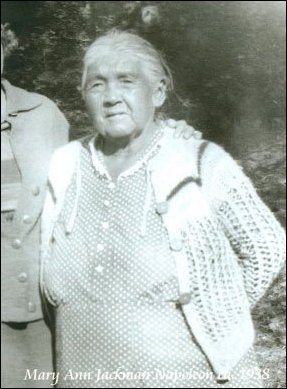 |
Mary Ann Jackman
|
Andrew and Mary Ann were related to several other notable pioneer families, both Caucasian and Indian. Mary Ann's sister Elizabeth or "Lizzie" Harry married Albert Bacon, the gold miner we mentioned above, who lived between Marblemount and Ruby creek. H.L. may be the Huey Bacon identified in some records; the 1892 census indicates that he was a farmer, 27 years old and was also born in Maine. The census also shows that his wife was named Fannie, age 32 and born in Kansas. One of Albert and Lizzie's sons was Leonard Bacon who was also a well-known and beloved upriver pioneer.
Actually, three Harry sisters married three neighbors, all of whom moved West together from Maine to California. Ellen, the third eldest Harry sister, married Archie Corkindale [also spelled McCorkindale in some records]. Like his in-law Albert Bacon and Andrew J. Jackman, an upriver creek is also named for him. Albert appears to be the first of the trio to move to the river because neither of the other two appears in the 1880 federal census of the mining district. We have written to Maine authorities to see if the three families were associated back there or if there is any blood relation between them. Marge recalled in her interview that each of the three sisters was tattooed with the mark of their common father, a ritual that is similar to that of the Suquamish tribe of Chief Sealth. The tattoo was applied on the wrist with a needle and juice from some kind of root; it was the design of an arrow and bar.
Andrew and Mary Ann's third child, Alice May, originally married Arthur H. Thompson in 1908. He died in a Great Northern Railway speeder accident at Winton, in the Tumwater Canyon area in 1927. She remarried in August 1929 to another son of a pioneer family, George Leggett, son of Henry Cooper Leggett, an 1870s pioneer of Utopia and Lyman. George was born in Lyman on Oct. 2, 1891, and he died on March 4 1958.
Jackman creek
We have not found a specific record of when the Jackman family moved to his namesake creek, which flowed through the future townsite of Van Horn. In Marge's 1977 interview, she only indicates that they moved to "the ranch" on the creek, apparently sometime after they lived in Marblemount. Shirley found in the family records a patent for a homestead on which pioneer John W. Benson proved up. The patent is signed by Grover Cleveland and is dated March 14, 1887. The legal description of the land, in section 13, T35N, R8E, puts it squarely on the banks of Jackman creek. The actual sale of that homestead to Andrew J. Jackman was recorded on Sept. 29, 1890. Andrew may have started the ranch earlier, before he sold the trading post, because Marge recalls firmly that Alice was born at the creek as was her younger sister.
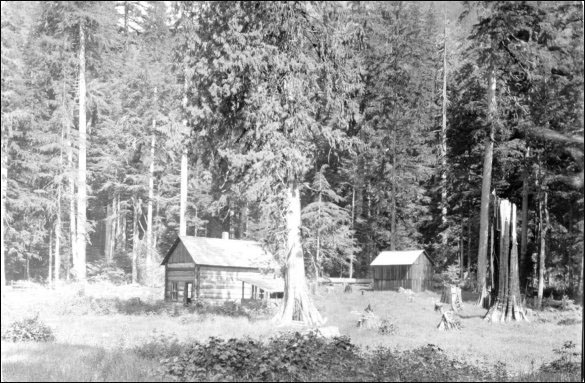
|
This lovely cabin in a dense upriver Skagit forest was similar to the home where George and Alice Leggett lived near Rocky creek from 1934 until their deaths in l958 and Alice in 1962.; theirs was originally a cabin for miners in the area.
|
When Jackman moved from Marblemount to the ranch at the creek, he pparently made his living from logging with oxen and from raising dozens of hogs. Mary Ann was very busy at the ranch with her young children and many chores. Marge recalled a story about her grandmother having an old sewing machine and an apparatus she used to card wool that was shorn from sheep on the ranch. She and her Indian family also had a portable smokehouse that they could tear down and roll to a new locations wherever the salmon were most plentiful. Marge also remembered stories of a large root house at the creek ranch, which was brimful of many staples that Indian families could not afford, including big barrels of flour, salted meats, canned goods and sugar. Mary Ann told Marge that life at the ranch was much easier than former life at the trading post/saloon.
Even after Jackman became a farmer along the creek, he still dabbled in mining. Marge recalled that his interests extended over the Cascades to Okanogan as early as 1884, when he sold part interest in a mine there for $400. He continued his interest there years later. The mining law in effect back then required that mine owners maintain and improve their claims yearly. Leonard Bacon also recalled that he helped his dad maintain their mines when he was a young man but they saw very little return. When Andrew became after the turn of the century, he lost one claim after another. After Andrew died, Mary Ann was probably victimized. Since she was illiterate, she may not have realized what she was giving up when she signed official documents with her X-mark. Andrew also continued logging while at the creek. We know from Marge's interview that Jackman owned a log boom at the creek that was extended out onto the river to trap shingle bolts that were floated down the river. He also had a skid road there and his daughter Alice remembered covering the corduroy pole-skids with dogfish oil. Both the mining and logging interests disappeared by the time he died in 1910, however; by then he was penniless.
A few mysteries of that time period remain unresolved. Marge notes that Andrew had some kind of interest in the trading post at Sterling, downriver, but we have been unable to find any record of him there, in among a string of owners from Jesse Beriah Ball to Paul Polson to Mortimer Cook. Another mystery is about Alice's school near the creek before James V. Van Horn applied his name to the village at the creek crossing. Alice told Marge that she attended "Gault" school. We have checked all records and cannot find any such school or any such village. In the 1890s, the only schools in the area were at Minkler's Landing, first; then Lyman was added, and then the Minkler school changed to Birdsview. Another mystery was solved. Sometime after the turn of the 20th century, a young man who resembled Andrew very much rode up into the yard. He had the same red hair that Andrew had as a young man. He turned out to be named Albert and he was the illegitimate son who resulted from an unmarried union Andrew had with a schoolteacher down in California. Shirley recalled meeting him when she was a child; she was born in 1937.
Alice chafed under Andrew's strict rule and she left the farm as soon as she could, at age 16 in 1903, the year after Van Horn became a town just north of the ranch. The only really happy times that Alice remembered were the instances of her mother's kindness and the barn dances they used to attend. She also recalled how skilled her mother was at finding the roots and herbs that she used to heal scratches and wounds for her family. Andrew J. Jackman died on May 23, 1910, at age 74, shortly after he moved to Everett to live with Alice — two years after she married; Mary did not go with him. We have very few details about his brother Joseph's life, except that he lived in Latona, north of Lake Union in Seattle, after the turn of the century, was a successful businessman there and died in 1912. Alice died on Sept. 2, 1962. We do not know where Mary Ann lived as a widow after Andrew's death, except for the brief note in the story above.
John Napoleon
Sometime later Mary Ann married John Napoleon. Napoleon was an Upper Skagit Indian who was highly respected and beloved by both his white and Indian neighbors at a time when many of his brethren in Skagit county were patronized or segregated. He was born on Sept. 21, 1873, on the south side of the Skagit near what is now referred to as the historic C.O. Davis ranch. At one time he was a preacher at the Shaker church near the Sauk river and he was related by blood to the Boome and Moses families. Marge spent a lot of time with them both and she recalled, "I know they was in love. They didn't know how to express it, you know, but you could just see the look . . . how they worshipped each other. A common bond that Mary Ann especially enjoyed was the Lushootseed language that she and John spoke together, a reminder of her childhood years. She also cooked for him in the old Indian methods.
Marge remembered that the couple lived in Van Horn for many years, possibly on the Andrew's original parcel near the mouth of the creek. In September 1919, John was working at the Van Horn Logging company when he was seriously injured by a rolling log that pinned him to an earth bank and broke his back. Sometime later he also worked at the Superior Portland cement plant in Concrete. Marge still lived in Everett when both John and Mary Ann died but she came back up often to enjoy their company and help them financially. John died on August 9, 1936, when he and Mary were living in a cabin near Batey slough, south of Sedro-Woolley and near the north entrance to the old Third street bridge that spanned the Skagit on the way to Clear Lake.
Napoleon was honored at funerals both at Lemley Funeral Chapel in Sedro-Woolley, and by his fellow Shakers at a church in Grasmere, the town just west of Concrete. Rev. Ruedger of the Bethel Tabernacle church officiated at Lemley's, with more than 100 pioneers, descendants and mourners attending. His brother Charlie Boome led a continuous 48-hour funeral at the Grasmere church. You can read at our Journal website about the unusual upshot of his death and funeral. Pioneer women and their female descendants who attended the Sedro-Woolley funeral had to wait for some time before the ceremony started and during that time they made plans to form a pioneer club that resulted in the Territorial Daughters of Washington.
Mary Ann lived as a widow for three years after that, mainly upriver with her Indian friends, until she took ill and was moved to the Tulalip Indian Hospital near Marysville. She died there at age 71 on Dec. 9, 1939. She was honored with a 48-hour Shaker funeral at the Grasmere church just as John Napoleon was, and Charlie Boome once more officiated. She was survived by her daughter Alice May Leggett who then lived near Rockport; and her daughter Linda Ruth McCowan, who lived with her husband, Fred "Mac" McCowan, in Ketchikan, Alaska. Marge Voth died on Oct. 8, l995.
Ed. note: Update May 2005 — just when we thought that we might have answered the many questions about this family, we discovered an 1891 timetable for the Fairhaven & Southern railroad. The first stop northwest of old Woolley, on what is now called the Old F&S Grade road, was named Jackman. Why and for whom? We have not yet found an answer. The site was exactly three miles from Woolley. We have begun to find an answer to where Andrew's brother Joseph lived. Although there are no addresses or location given, in both the 1885 and 1887 territorial census, Andrew and Joseph's families are listed together, somewhere upriver. By the 1892 census, Joseph appears to have moved downriver, possibly to the area between Mount Vernon and the South fork of the Skagit. Hugh Bacon does not appear until the 1889 and 1892 territorial census, so he must not have moved to the upper Skagit river until after Albert mined there in 1879-80. In both years, their families are listed next to each other, so we are inclined to believe that they were brothers.
Story posted on April 24, 2005
Did you enjoy this story? Please consider subscribing to the optional Subscribers Edition. That is how we fund this grand project.
Please report any broken links or files that do not open and we will send you the correct link. Thank you.
|
You can read about our prime sponsors:
Read the history websites of our sponsors and supporters, who help fund research of local history:
Heirloom Gardens Natural Foods at 805B Metcalf street, the original home of Oliver Hammer.
Oliver Hammer Clothes Shop at 817 Metcalf street in downtown Sedro-Woolley, 82 years.
Bus Jungquist Furniture at 829 Metcalf street in downtown Sedro-Woolley, 36 years.
Schooner Tavern/Cocktails at 621 Metcalf street in downtown Sedro-Woolley, across from Hammer Square.
Peace and quiet at the Alpine RV Park, just north of Marblemount on Hwy 20
Park your RV or pitch a tent by the Skagit river, just a short driver from Winthrop or Sedro-Woolley.
Would you like to buy a country church, pews, belfry, bell, pastor's quarters and all? Email us for details.
|
|
|
Did you find what you were looking for? If not, please email us and tell us what you seek and we will put it on our list to research. The more details, the better.
|
Please sign our guestbook so our readers will know where you found out about us, or share something you know about the Skagit River or your memories or those of your family. Share your reactions or suggestions or comment on our Journal. Thank you for taking time out of your busy day to visit our site.
|
Sign Our Guestbook

View Our Guestbook
|
Remember, we welcome correction and criticism. Please click on the email slot at the right to report any problems with these pages or to suggest ideas for future stories. This is a completely free site. We fund it by providing an online magazine for paid subscribers. If you are not already a subscriber and you would like to help support our considerable research costs, you can subscribe for just $20.00 per year. As a paid subscriber, you will receive eight yearly issues plus many rare treats between times, including scans of photos and documents that illustrate local history, before they are shared with anyone else. You can go here for Subscription details and you can read the preview edition to see examples of our in-depth research. You may also order gift subscriptions for friends, family or clients who are interested in local history or students or military people who are away from home. Or you can email us for more details. Do you have scanned photos to share? Or you can mail us copies. See addresses to right.
|
Email us at: journal@stumpranchonline.com

Mail copies/documents to street address: Skagit River Journal, 810 Central Ave., Sedro-Woolley, WA, 98284.
|

 810 Central Ave., Sedro-Woolley, Washington, 98284
810 Central Ave., Sedro-Woolley, Washington, 98284




